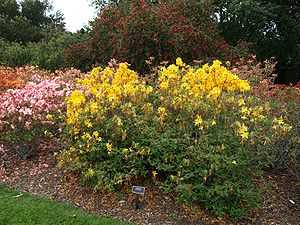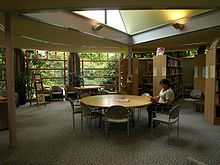Auckland Botanic Gardens

Auckland Botanic Gardens, Auckland, New Zealand is a botanical garden that covers 64 hectares[1] in Manurewa, South Auckland. The first purchase of land by the Auckland Regional Authority (ARA) – predecessor of Auckland Regional Council (ARC) – dates back to 1968. Developments started in 1973. The garden was officially opened to the public in 1982. In that same year the first (and until now only) Visitors Guide was published.[2] It now holds more than 10,000 plants.
History of the Gardens
1926 - 1968
The first concept for a botanical garden in the Auckland region started in 1926, when members of the Auckland District Horticultural Society suggested such an attraction for Auckland.[3] In October, 1928, a report was forwarded to the then Parks Committee of the City Council with recommendations. This was approved by the Committee. The Committee recommended to put aside part of the Auckland Domain for the purpose. "Since then, very little further has been done".[4] In 1945 Churchill Park was considered.[5] In the 1950s many sites were investigated for housing a botanic garden.[6] In 1957 V. J. Chapman, professor of botany at Auckland University College, drew attention to the fact that Auckland, alone among New Zealand's chief cities, had no botanic garden. He pointed out that the city could acquire 80 acres (320,000 m2) of land at the Tamaki property of the University.[4] In 1960 an ad hoc committee was formed to try to find a suitable site and to secure its development as a botanic garden. In 1963 it became clear that land at Tamaki was not feasible. The search continued. Finally, in 1964, an area of land in the Manurewa suburb was examined with positive results.[5]
1968 - 1989
On 9 February 1968 the Auckland Regional Authority acquired 42 hectares of land from the Nathan Estate in Manurewa, and the Manukau City Council bought the remaining 40 hectares of the Estate, since the property was offered as a whole.[7] The land was leased for grazing until 1970. Soil tests were carried out. These proved that the area was most suitable for a botanic garden.[5]
A scientific advisory committee prepared the first master plan for the Gardens. This was adopted by Council in March 1972. On 19 February 1973 the then Auckland City Councillor, Tom Pearce, turned the first sod. A nursery was established at the eastern end of the Hill Road frontage.
In 1982 the Auckland Regional Authority bought approximately 20.5 ha from Manukau City and accepted from it a gift of 2.2 ha to give the Gardens a northern frontage onto Orams Road.
23 February 1982 the Gardens were officially opened by David Bellamy. At that time the facilities included a visitor centre, the courtyard, the carpark and public toilets. The plant collections were confined to the southern parts of the Gardens.
In 1983 the Sir John Logan Campbell Lecture Building was erected. In 1986 an entrance at Katote Place was constructed in memory of Mr. Harry Beaumont, a former member of both the Auckland Regional Authority and Manukau City Council, and a strong promoter of the establishment of the Gardens. That same year the Unitec Horticultural Classroom and an associated demonstration home garden were opened.[7]
A review of the role and activities of the Gardens was undertaken in 1988-89 by a working party.[8]
Numbers of visitors
In the first years after the opening in February 1982 the visitor numbers were relatively stable around 100,000 visits per annum. 1988: 143,000.[9] From 1988 to 1994 a rapid increase took place (numbers counted over the season July to June):[10]
| 1988/9 | 157,959 |
| 1993/4 | 494,634 |
Mission
The mission of Auckland Botanic Gardens is threefold:[11]
- to contribute to the community's wellbeing and appreciation of plants.
- to reflect in the range of plants on display the region's benevolent climate, its diverse landscape and its ethnic mix.
- to meet the needs and interests of the community and to inspire and inform people about the importance of plants in their lives and to the environment.
Research
Research in the Botanic Gardens has been mainly directed on identifying plants that are best suited to growing in local conditions. Three panels have been active, on natives, on trees and shrubs, and on bulbs and perennials. As a result of this research a great number of Advisory Leaflets was published, together forming the dossier "Gardening in Auckland – Horticultural advice for Auckland gardeners" (published regularly since 1981), freely available at the visitor centre. Much of the trials have been conducted in the Shrub Trial Garden. Here some extensive collections have been created of Hydrangea, azalea, Deutzia and other genera. Nowadays the advisory work is still continued and the Advisory Leaflets are still updated regularly.[12]
Plant conservation
Auckland Botanic Gardens take an active role in plant conservation, especially of threatened New Zealand native plants. A good example is the shore spurge Euphorbia glauca.
Collection
Important collections of the Auckland Botanic Gardens include:
- New Zealand Native Plant Collection, in several areas:
- - The New Zealand Native Plant Identification Trail
- - The Native Forest Trail, a marked walk that leads through a broadleaf/podocarp forest remnant with a total of about 30 hectares. 10 hectares are part of the Botanic Gardens and managed by Auckland Regional Council. 20 hectares are part of 'Totara Park', managed by the Manukau City Council. The area was cut in earlier times to harvest timber. The forest is now regenerating. There are a number of tracks in the area. One of the tracks is described in a leaflet with information on plants and trees. The flora of the combined area consists of 158 species in total.[13]
- - The Flax (Phormium) Collection, with a large number of cultivars.
- - The Threatened Native Plant Collection, opened 2001 by Helen Clark, in those days Prime Minister of New Zealand. Here we find for instance fine specimen of Three Kings (Trumpet) Vine Tecomanthe speciosa and of Shore Spurge.
- - Native Plant Ideas.
- - Kauri Grove.
- The Roses.
- The Children's Garden
- The Shrubs Trial Garden.
- The Gondwana Arboretum.
- The Edible Garden.
- The Perennial Garden.
- The Camellia Garden.
- The African Garden
- The Rock Garden
- The Palm Garden.
- Urban Trees, which shows a selection of small trees that can be successfully planted in private gardens.
There are a number of other collections, for instance a small collection of conifers, with nice specimen of Keteleeria davidiana and Bishop Pine Pinus muricata.
The database, that contains all the plants in the collections, is available for consultation in the Visitor Centre.
 Visitor centre  Interior of the library |
Visitor Centre
The Visitor Centre Huakaiwaka is a modern building, opened 2005 that houses the information desk, information displays, a café, and offices.
Library
The Horticultural Reference Library is housed in a separate building. The building was opened in 1992 and was funded by the Friends of the Auckland Botanic Gardens. It contains some 2,500 books and a number of horticultural journals and magazines. The catalogue holds about 10,000 items.[12] The library is open to the public.
The huge impact of the activities of the Friends is clearly demonstrated by the fact that in 1989 the library housed only 400 volumes in the Information Centre, that were solely used for reference by staff.[14]
Ellerslie Flower Show
The Ellerslie Flower Show was a very successful event which eventually outgrew its original location at the Ellerslie Race Course. For a number of years the Manurewa Gardens were used for the show until 2008 when it moved to Hagley Park in Christchurch.
Literature
- An. (1982) - Auckland Regional Botanic Gardens. A Visitors Guide. An Auckland Regional Authority Project.
- Auckland Regional Authority, Regional Parks Department (1989) - Auckland Regional Botanic Gardens, Working Party Review. Review of Role and Activities and Recommendations. February 1989. Report to Regional Parks Committee (chairman J.F. Pettit)
- Auckland Regional Council, Parks Service (1995) - Auckland Regional Botanic Gardens, Management Plan. May 1995
- Chapman, Professor V.J. (1957) – 'Unique chance for city to get land for botanic garden' in The Auckland Star, 1957/03/12
- Chapman, V. J. (1972) – 'Slow Start: Bright Outlook for Botanic Gardens' in New Zealand Herald (Auckland), 1972/4/10
- Higham, George (1993) – We wonder who'll be next. A collection of addresses by various guest speakers of the Papakura & Districts Historical Society over the past few years. Papakura, New Zealand. p. 91/2: Auckland Regional Botanic Gardens at Manurewa.
Footnotes
- ↑ Auckland Regional Council, Parks Service 1995, p. 7
- ↑ An. 1982
- ↑ Higham 1993, p. 91. See also Chapman 1972 ("April, 1926"). Chapman 1957 dates the first proposals back to 1927
- ↑ 4.0 4.1 Chapman 1957
- ↑ 5.0 5.1 5.2 Chapman 1972
- ↑ Higham 1993, p. 91 says 1953. Chapman 1972 says between 1954 and 1959
- ↑ 7.0 7.1 Auckland Regional Council, Parks Service 1975, p. 20
- ↑ Auckland Regional Authority, Regional Parks Department 1989
- ↑ Auckland Regional Authority, Regional Parks Department 1989, p. 16
- ↑ Auckland Regional Council, Parks Service 1995, p. 25
- ↑ Vision as stated on the website of the Gardens
- ↑ 12.0 12.1 verbal information by librarian 2008-11-10; see also: History of ARBG (Auckland Regional Botanic Gardens → nowadays: Auckland BG) Plant Evaluation Panels & Advisory Leaflets
- ↑ Auckland Regional Council, Parks Service 1995, p. 12
- ↑ Auckland Regional Authority, Regional Parks Department 1989, p. 38
External links
Coordinates: 37°00′47″S 174°54′27″E / 37.0130°S 174.9075°E